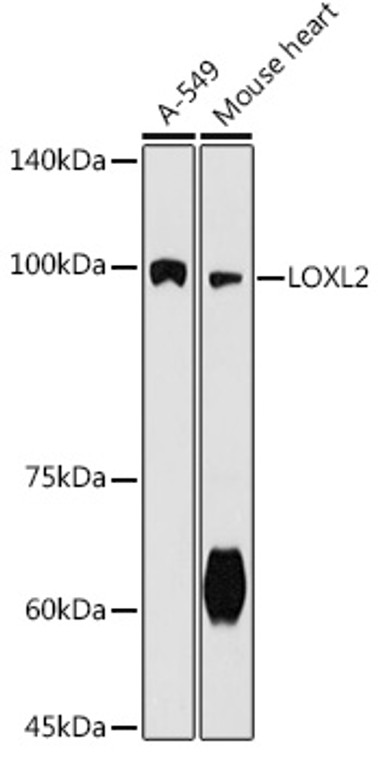| Host: |
Rabbit |
| Applications: |
WB |
| Reactivity: |
Human/Mouse/Rat |
| Note: |
STRICTLY FOR FURTHER SCIENTIFIC RESEARCH USE ONLY (RUO). MUST NOT TO BE USED IN DIAGNOSTIC OR THERAPEUTIC APPLICATIONS. |
| Short Description: |
Rabbit polyclonal antibody anti-LOXL2 (51-290) is suitable for use in Western Blot research applications. |
| Clonality: |
Polyclonal |
| Conjugation: |
Unconjugated |
| Isotype: |
IgG |
| Formulation: |
PBS with 0.05% Proclin300, 50% Glycerol, pH7.3. |
| Purification: |
Affinity purification |
| Dilution Range: |
WB 1:100-1:500 |
| Storage Instruction: |
Store at-20°C for up to 1 year from the date of receipt, and avoid repeat freeze-thaw cycles. |
| Gene Symbol: |
LOXL2 |
| Gene ID: |
4017 |
| Uniprot ID: |
LOXL2_HUMAN |
| Immunogen Region: |
51-290 |
| Immunogen: |
Recombinant fusion protein containing a sequence corresponding to amino acids 51-290 of human LOXL2 (NP_002309.1). |
| Immunogen Sequence: |
ANVAKIQLRLAGQKRKHSEG RVEVYYDGQWGTVCDDDFSI HAAHVVCRELGYVEAKSWTA SSSYGKGEGPIWLDNLHCTG NEATLAACTSNGWGVTDCKH TEDVGVVCSDKRIPGFKFDN SLINQIENLNIQVEDIRIRA ILSTYRKRTPVMEGYVEVKE GKTWKQICDKHWTAKNSRVV CGMFGFPGERTYNTKVYKMF ASRRKQRYWPFSMDCTGTEA HISSCKLGPQVSLDPMKNV |
| Tissue Specificity | Expressed in many tissues. Highest expression in reproductive tissues, placenta, uterus and prostate. In esophageal epithelium, expressed in the basal, prickle and granular cell layers. Up-regulated in a number of cancers cells and tissues. |
| Post Translational Modifications | The lysine tyrosylquinone cross-link (LTQ) is generated by condensation of the epsilon-amino group of a lysine with a topaquinone produced by oxidation of tyrosine. N-glycosylated. N-glycosylation on Asn-455 and Asn-644 may be essential for proper folding and secretion.may be composed of a fucosylated carbohydrates attached to a trimannose N-linked glycan core. |
| Function | Mediates the post-translational oxidative deamination of lysine residues on target proteins leading to the formation of deaminated lysine (allysine). Acts as a transcription corepressor and specifically mediates deamination of trimethylated 'Lys-4' of histone H3 (H3K4me3), a specific tag for epigenetic transcriptional activation. Shows no activity against histone H3 when it is trimethylated on 'Lys-9' (H3K9me3) or 'Lys-27' (H3K27me3) or when 'Lys-4' is monomethylated (H3K4me1) or dimethylated (H3K4me2). Also mediates deamination of methylated TAF10, a member of the transcription factor IID (TFIID) complex, which induces release of TAF10 from promoters, leading to inhibition of TFIID-dependent transcription. LOXL2-mediated deamination of TAF10 results in transcriptional repression of genes required for embryonic stem cell pluripotency including POU5F1/OCT4, NANOG, KLF4 and SOX2. Involved in epithelial to mesenchymal transition (EMT) via interaction with SNAI1 and participates in repression of E-cadherin CDH1, probably by mediating deamination of histone H3. During EMT, involved with SNAI1 in negatively regulating pericentromeric heterochromatin transcription. SNAI1 recruits LOXL2 to pericentromeric regions to oxidize histone H3 and repress transcription which leads to release of heterochromatin component CBX5/HP1A, enabling chromatin reorganization and acquisition of mesenchymal traits. Interacts with the endoplasmic reticulum protein HSPA5 which activates the IRE1-XBP1 pathway of the unfolded protein response, leading to expression of several transcription factors involved in EMT and subsequent EMT induction. Involved in E-cadherin repression following hypoxia, a hallmark of EMT believed to amplify tumor aggressiveness, suggesting that it may play a role in tumor progression. When secreted into the extracellular matrix, promotes cross-linking of extracellular matrix proteins by mediating oxidative deamination of peptidyl lysine residues in precursors to fibrous collagen and elastin. Acts as a regulator of sprouting angiogenesis, probably via collagen IV scaffolding. Acts as a regulator of chondrocyte differentiation, probably by regulating expression of factors that control chondrocyte differentiation. |
| Protein Name | Lysyl Oxidase Homolog 2Lysyl Oxidase-Like Protein 2Lysyl Oxidase-Related Protein 2Lysyl Oxidase-Related Protein Ws9-14 |
| Database Links | Reactome: R-HSA-1566948Reactome: R-HSA-2243919 |
| Cellular Localisation | SecretedExtracellular SpaceExtracellular MatrixBasement MembraneNucleusChromosomeEndoplasmic ReticulumAssociated With ChromatinIt Is Unclear How Loxl2 Is Nuclear As It Contains A Signal Sequence And Has Been Shown To Be SecretedHoweverA Number Of Reports Confirm Its Intracellular Location And Its Key Role In Transcription Regulation |
| Alternative Antibody Names | Anti-Lysyl Oxidase Homolog 2 antibodyAnti-Lysyl Oxidase-Like Protein 2 antibodyAnti-Lysyl Oxidase-Related Protein 2 antibodyAnti-Lysyl Oxidase-Related Protein Ws9-14 antibodyAnti-LOXL2 antibody |
Information sourced from Uniprot.org
12 months for antibodies. 6 months for ELISA Kits. Please see website T&Cs for further guidance








